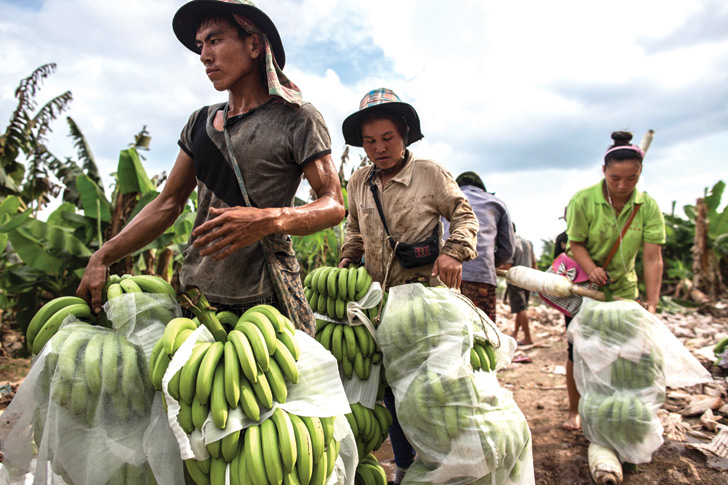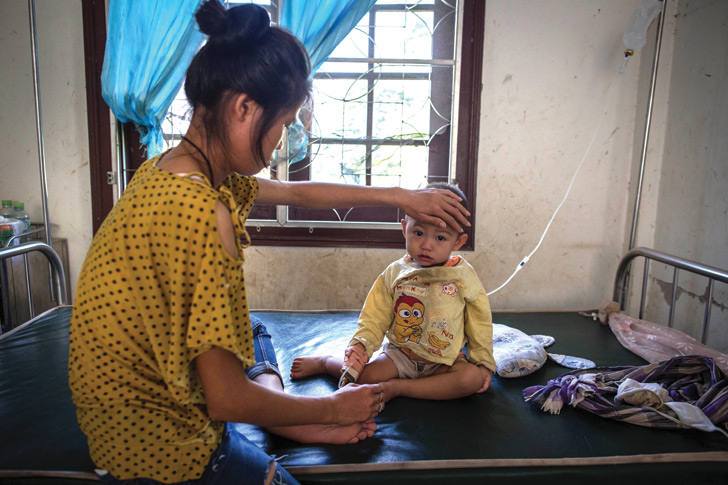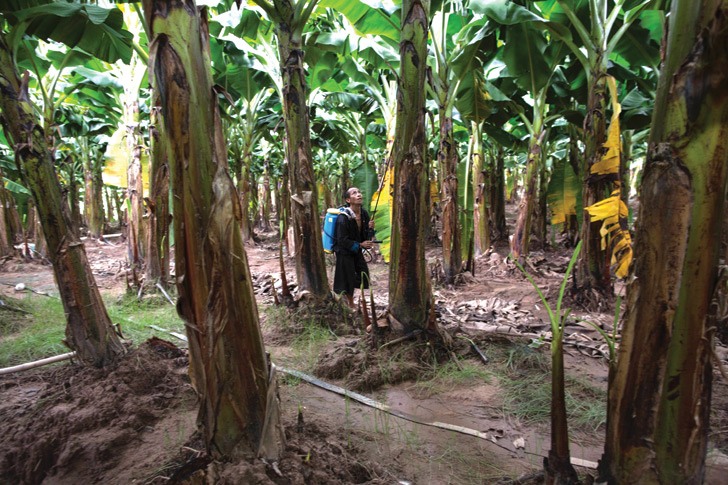In the heart of Ton Pheung district, in the Lao province of Bokeo, scores of Laotians stop by regularly to revere a huge, 15th-Century statue of Buddha. Sticks of burning incense are left sprouting from the ground, where they are joined by small flower garlands and bottles of fruit juice in a ritual that has been observed for generations.
However, the revered statue’s surroundings have been radically transformed in the past five years. “Before, you had orchards and rice fields where Laotian farmers were working,” says Kalia Sompavong, a lanky local youth who works as a tour guide. “But now, 90% of the villagers are renting their land [for] banana plantations.”

Where once the Buddha’s caring eyes observed the soporific flow of local life, he now gazes across hundreds of hectares of banana trees that are owned by Chinese entrepreneurs and stretch off in every direction. The plantation area is so large that it takes a full hour to cross it by car.
“The Chinese are renting 1,600 square metres of land for the equivalent of between $300 to $600 per year, which is roughly what the farmers would earn from this area if they cultivate the land. So they get the same amount but don’t have to work,” says Sompavong.
However, such deals always have their negative sides. For instance, the concession contracts usually do not specify that the investor has to clean up the land – often rice paddies – and return it to its previous condition after the contract ends.
“There are big economic incentives to rent out the land, because it represents a large amount of cash that Laotian villagers could never get in one go from their farming work. [But there are a lot of consequences] in terms of chemical inputs used by the Chinese investors, destruction of land markers and destruction of traditional irrigation channels,” says Cecilie Friis, a human geographer at Humboldt University in Berlin who, last May, wrote a study titled Chinese Banana Investments in Northern Laos.
Plantation workers are also getting paid. They typically earn between $120 and $150 a month in a country where the national income per capita is estimated at $137 a month by the World Bank. The majority of the workers are from marginalised ethnic minority groups who previously relied on subsistence farming.
Yet the banana rush in the plains of northern Laos is just one element of a larger phenomenon. Chinese entrepreneurs, deprived of economic opportunities in overcrowded southern China, are increasingly willing to venture across the border to a country where people are scarce and land is plentiful.
“If a Chinese businessman goes to Laos, he will be given financial help amounting to more than $10,000 by local authorities in China. But this is on the condition of not coming back to China for a fixed number of years. His mission is to become a successful entrepreneur,” says a French expert who studies agricultural plantations in northern Laos, and who, like so many in Laos, asked not to be identified.
Chinese economic influence over Laos is nothing new; nor is the arrival of enterprising Chinese. But the superpower’s economic penetration of its smaller neighbour has increased considerably in recent years, particularly since Laos’ GDP took off with real growth of 8.5% in 2013 and 7.5% in 2014 according to the World Bank – figures that outstripped China’s.
At the beginning of 2014, China became the largest investor in Laos with $5.1 billion of accumulated investments. This amounted to about 40% of total foreign investments and saw China overtake Thailand and Vietnam. Chinese companies dominate the mining, transportation, plantation and hydroelectric sectors. Lao exports to China increased by 300% between 2005 and 2013, largely as a result of shipments of agricultural products grown by Chinese companies.
Nonetheless, official statistics for the number of Chinese investors working in Laos are hard to come by. The Chinese embassy in Vientiane did not respond to repeated requests for data. Circumstantially, during Southeast Asia Globe’s eight-day trip to the northern provinces of Luang Prabang, Oudomxay, Luang Namtha and Bokeo, the Chinese influence was overt. Chinese signs are omnipresent in cities such as Muang Xay and Huay Xai, the capitals of Oudomxay and Bokeo provinces respectively. In areas such as the Golden Triangle Special Economic Zone in Bokeo, where a private Chinese company built a casino, Chinese is the only language spoken.
The Chinese migrants have been investing in almost everything in northern Laos – from hotels and bakeries to rubber plantations. But it is the huge banana estates, which cover most of Bokeo province and parts of Oudomxay and Luang Namtha, that stand out as their greatest achievement.
The attraction of Laos lies in a combination of factors, according to Cecilie Friis. “The main reason given by the Chinese banana investors for moving into Laos was the availability of suitable land and favourable climatic conditions for banana plantations – something [that] often contrasted with the situation in China,” she wrote in her study published last May.
The impossibility of growing bananas during the Chinese winter, the greater price of land there and the prevalence of a soil pathogenic disease that infects the root systems of banana palms – the Panama fungal virus – also come into play, she added in the study.
However, what at first seemed like a good deal for the impoverished Laotian farmers is turning out to be anything but positive, with unexpected side effects rapidly outweighing the economic advantages.
About 30 Laotian workers live in a camp located inside a Ton Pheung banana plantation. The atmosphere is bleak.
“We all have headaches, although we’re wearing masks when we spray pesticides on the trees,” says Sith, an ethnic Khmu from the mountains of neighbouring Xayaburi province. “My son doesn’t eat any more. He always feels like vomiting,” he adds, pointing out a teenager with patches of depigmented skin.
A few metres away a man in a stained shirt is squatting in a hut, his head bowed. “His six-month-old child died two weeks ago,” explains a trader who comes daily to sell food and drinks in the camp. “[The child] went yellow and began to vomit blood. The doctor said it was a liver problem.”
At a hospital next to the plantation, a doctor, who gave his name as Bounkhong, confirms that the massive use of pesticides is a clear health risk. “Most of our patients are workers from the plantations, particularly their children. They vomit, have fever and diarrhoea. Tests show that their lungs are affected,” he says.
Such situations are feeding an anti-Chinese sentiment that is beginning to bubble over in Laos’ northern regions. Demonstrations are rare in tightly controlled Laos, but in August the residents of Sibounheung village took to the streets to protest when they faced displacement after their land was included in a 99-year concession for a private Chinese company to extend its hotel-casino complex. Perhaps surprisingly, the villagers were successful in stalling the plan.
“The government bought our rice fields for $2,800 per rai [1,600 square metres]. We proposed them back for $5,600, but they refused. That is why we demonstrated,” says a young monk at the village pagoda.
Other protests took place across social networks. A plan to allow China’s A-Cho Group to develop land around the Kuang Si waterfall, one of the most famous natural sites in the country, was aborted when thousands criticised the project online.

“Soon the word ‘Lao’ will disappear from northern Laos and everything will be controlled by the Chinese, because the Laotian government leaders have sold this part of the country to China,” wrote Sine Kounlavong, a Laotian reacting to the project on his Facebook page.
This anti-Chinese sentiment probably added to the central government’s sense of urgency when the pesticide problems became a major talking point in the villages of Bokeo and Oudomxay provinces late last year. As a result, some provincial power holders were transferred and replaced by officials from Vientiane.
Then, at the end of September, the Ministry of Agriculture and Forests warned four Chinese companies for “excessive use of pesticides” and ordered inspections on the types and amounts of chemicals used at some of the banana plantations. The revocation of business licences was threatened if laws continued to be contravened.
In mid-October, the creation of new plantations was banned by provincial authorities in Bokeo, Luang Namtha and Oudomxay provinces after Chinese-owned banana farms were found to have used and leaked hazardous chemicals into the soil. But despite these seemingly positive steps, it seems unlikely that the country’s yellow rush will end any time soon.
“From what I have seen in Luang Namtha province, even if there is a ban on renting out paddy fields for banana plantations, farmers still rent out their land illegally,” said Friis. “The economic benefits of it are just too great.”
It’s not just bananas
A brief look at other Chinese business interests in Laos
Casinos
Since 2003, two ‘casino zones’ have been granted as 99-year concessions to Chinese private companies. The 21-square-kilometre Boten casino zone, run by notorious Chinese businessman Huang Minxuan, was closed in 2011 due to a rise in criminality. It reopened at the beginning of 2015.
The 101-square-kilometre Golden Triangle Special Economic Zone is a huge resort city whose cumulative investment is expected to reach $2.25 billion by 2020. Its top draw is the Chinese-owned Kings Romans Casino, which was the subject of a Guardian exposé titled “High-end Laos resort serves up illegal wildlife for Chinese tourists”.
Dams
Of the nine dams being planned on the Lao section of the Mekong, Chinese developers and investors have interests in at least four. The most controversial is the famed Xayaburi dam, which is predicted to have disastrous consequences for downstream communities’ way of life.
Meanwhile, Chinese state-owned China Southern Power Grid has a stake in the Nam Thai 1 dam. Its construction would require the resettlement of nearly 8,000 mostly indigenous people, according to International Rivers.
Rail
The 420-kilometre rail link between Kunming in southwestern China and the Lao capital of Vientiane comes with a projected price tag of $6.3 billion, which is equivalent to 60% of Laos’ GDP. An estimated 70% of the cost will be financed through a loan extended by China’s Export-Import Bank. The loan is tied to long-term concessions to China for mineral rights as well as timber and agricultural concessions in Laos.



